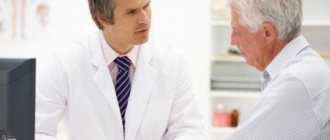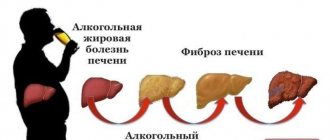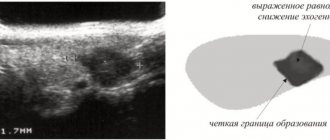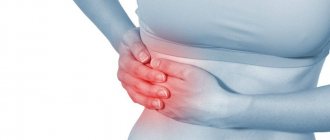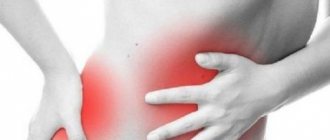Pain on the right under the ribs from behind from the back is an unpleasant symptom that can appear when the functioning of various organs is disrupted. If unpleasant and painful sensations appear in this area, you need the help of a rheumatologist and other specialists who work at the Yusupov multidisciplinary hospital.
Pain in the right hypochondrium can appear not only with disorders of the musculoskeletal system, but also with other systems. At the Yusupov Hospital, high-precision diagnostics are carried out, aimed at collecting the most detailed information about the patient’s current condition.
What is on the right side of the abdominal cavity?
The content of the article
The abdominal cavity contains many internal organs, the stomach, intestines, pancreas, kidneys, adrenal gland, spleen, liver, pancreas, gall bladder. They are not protected, unlike the heart or lungs, by ribs. They are protected only by the muscles of the abdominal wall (abs).
Problems with any of the organs manifest themselves in the form of tingling, nagging pain and discomfort in various areas of the abdomen. If you experience periodic pain in your right side, you should consult a doctor to determine which organ has problems.
The abdominal cavity consists of 9 parts and is divided into 3 sections:
- Epigastrium
. The epigastrium itself is located directly above the navel. On the right is the subcostal region. - Mesogastrium
. Consists of the peri-umbilical and right lateral regions. - Hypogastrium
. Includes the suprapubic and right iliac region.
Due to the different anatomical structure, pain of the same nature and intensity, localized in the same place, in men and women indicates different diseases.
The following organs are located in the area of the right hypochondrium:
- flexure of the colon of the large intestine;
- right kidney (from the back);
- liver;
- gallbladder;
- right adrenal gland;
- the right half of the diaphragm (the muscle that separates the peritoneum and sternum).
Sometimes pain radiates from organs located elsewhere, for example, from the pancreas or inferior vena cava. In this case, it seems to the person that it hurts on the right side, but in fact the true cause of the pain is in another area.
Urinary tract diseases
Pain on the right side may be caused by urolithiasis. If the right ureter is affected, there may be pain on the right in the abdomen and lower back1, 2. When the stone moves, the pain on the right can move to the lower abdomen, radiate to the genitals, and the inner thighs. If the stone is located in the lower third of the right ureter, the person is bothered by a constant painful urge to urinate2, 13. The pain is usually wave-like in nature, and for spasms in diseases of the urinary tract, the use of antispasmodics, for example No-shpa®, may be indicated or No-shpa® forte7, 13, 16, 22. The passage of stone or sand from the ureter is often manifested by pain and blood in the urine13.
Causes of pain in the right hypochondrium
Pain in the right side of the abdomen does not always indicate any disease. At times they are caused by physiological changes that also happen to completely healthy people.
- Stitches in the side after jogging
or other physical activity. This is typical for unprepared people who are not used to playing sports. Physical activity is stressful for their body, and it reacts with a sharp release of adrenaline. The hormone provokes a spasm of the bile ducts, which stretch from the bile overflowing them. At the same time, the liver fills with blood, increases in size, and the organs press on each other, causing pinpoint pain and tingling. - Tingling in the right side
after a heavy meal. On a full stomach you don’t want to move or move. Under the influence of adrenaline, the inferior vena cava expands and puts pressure on the liver, which is also under pressure from a full stomach. This is why you should not exercise immediately after eating. - Sharp pain in the right side
, radiating to the back. This happens in women shortly before the start of menstruation. Hormonal imbalance causes spasm of the bile ducts, resulting in sharp pain that radiates to the back. It goes away on its own, but causes significant discomfort to the woman. - Pain in the right side during pregnancy
. The uterus, stretched under the influence of the growing fetus, puts pressure on neighboring organs. Also, the hormone progesterone, secreted to relax smooth muscles and prevent miscarriage, provokes stagnation of bile (cholestasis in pregnant women). Many pregnant women experience pain in the right hypochondrium, which intensifies with movement. Therefore, women need to limit their loads and walk more at a slow pace. - Cramps in the lower abdomen (not menstrual)
. Hepatic, renal, and intestinal colic are characterized by irradiation—reflection of the pain signal to another part of the body.
Help the liver with Phosphogliv*
If liver problems are detected, the patient is prescribed diet and exercise; if this is not enough, therapy is supplemented with medications. It often includes the use of hepatoprotectors - drugs for treating the liver. One such drug is Phosphogliv*. Phosphogliv* is used as a means of pathogenetic therapy. This product contains 2 active ingredients: glycyrrhizic acid and essential phospholipids.
Glycyrrhizic acid has anti-inflammatory, antioxidant and antifibrotic effects, which allows the drug to be used both at the stage of treating inflammation and for preventing its development, and essential phospholipids restore damaged liver cell membranes. The use of the drug Phosphogliv* ensures normalization of the patient’s general condition, relief of the inflammatory process in the liver - a decrease in ALT and AST enzymes, and also helps prevent the development of fibrosis and cirrhosis.
Pain in the right side not associated with internal organs
Abdominal pain with depression
. Depression is accompanied by increased anxiety and increased levels of norepinephrine and cortisol. They cause spasms of smooth muscles, including the intestines. The person experiences symptoms characteristic of indigestion. Moreover, this is not associated with eating low-quality food. Abdominal pain cannot be relieved by medications because it is psychosomatic in nature.
A severe and persistent cough also causes abdominal pain
. This is due to the increased load on the abdominals, which not everyone has trained and strong. Often coughing, the patient strains the muscles, they stretch and put pressure on the diaphragm, causing a dull pain. It goes away on its own after the cough is cured.
What can hurt in the stomach on the right?
The causes of pain under the right rib can also be diseases in various organs:
- Liver diseases
: hepatitis (inflammation), hepatosis (metabolic disorders), cirrhosis (replacement of parenchymal cells with connective tissue), liver parasites, metastases as a result of malignant tumors of other organs. - Heart diseases
(they cause circulatory disorders): myocarditis, endocarditis, coronary heart disease, abdominal myocardial infarction. - Gallbladder diseases
: cholecystitis (inflammation), cancerous tumors. - Intestinal diseases: colitis (inflammation of the mucous membrane of the large intestine), Crohn's disease (severe damage to the entire gastrointestinal tract from the throat to the anus), diarrhea, diverticulosis (protrusion of the intestinal mucosa through the muscle wall), irritable bowel syndrome, intestinal infections.
- Diseases of the right kidney
: abscess (purulent inflammation), pyelonephritis (bacterial inflammation), cysts, kidney stones, echinococcosis (presence of helminths in the kidney), tuberculosis (drying) of the kidney, malignant tumor. - Diaphragmatitis (inflammation of the pleura covering the diaphragm).
- Adrenal tumors.
- Intercostal neuralgia (irritation of the intercostal nerves).
- Formation of blood clots in the inferior vena cava.
Pain in the right side of the lower abdomen
Often pain in the lower abdomen in women
associated with the onset of menstruation. They are caused by the fact that the uterus is poorly supplied with blood these days, and a situation similar to a myocardial infarction arises. Only in this case does a spasm of the uterine muscle occur.
The intensity of the pain is similar to the cardiac pain during a heart attack. Every sexually mature woman has experienced these sensations at least once in her life, and will not confuse them with anything. The source of pain is localized above the pubic bone, sometimes radiating to the side. This should not cause concern, but the painful sensations should not be tolerated. It is better to take an antispasmodic and be sure to go for an ultrasound. In some cases, too much pain, accompanied by nausea and loss of creation, indicates pathologies of the uterus and ovaries, and requires a mandatory consultation with a gynecologist.
- Pain to the right of the navel
indicates possible appendicitis (inflammation of the appendix - an appendage of the cecum). - Acute cramping pain on the right side
just below the navel indicates inflammation of the fallopian tubes and ovaries (adnexitis) or inflammation of the ovaries (oophoritis), rupture of an ovarian cyst, torsion of a cyst, ectopic pregnancy, urolithiasis and cholelithiasis. The same symptoms indicate a pinched inguinal hernia (protrusion of the peritoneum in the inguinal canal). If you are predisposed to the disease (it occurs in 3% of women and 27% of men), you should immediately call an ambulance. There is a danger of necrosis of the hernial sac. - Aching pain in the right side at the level of the navel indicates inflammation of the small intestine (enteritis), appendicitis, and in the projection of the navel from the back indicates pleurisy - inflammation of the pleura (the serous membrane covering the diaphragm).
Acute pain under the ribs: possible consequences
If it burns and cuts severely for half an hour, you need to call an ambulance. This means that acute inflammation has arisen in the body, which can provoke a state of shock, complications and even death. Acute pain under the ribs are signs of the following diseases:
- An attack of acute pancreatitis;
- Gallstone rupture;
- Appendicitis;
- Breakthrough of the duodenal wall;
- Blockage of the bile duct with a stone;
- Kidney rupture due to injury.
All conditions require surgical intervention.
What to do if there is a burning sensation in the right hypochondrium
If the pain is characterized as aching and does not cause severe discomfort, experts recommend taking 2 No-Shpy tablets. This measure will help reduce pain, but it is necessary to diagnose the body and find out the cause of the discomfort.
What to do if there is pain in the right side
For pain in the side, if the doctor cannot “by eye” determine the cause of the ailment, he sends the patient for an ultrasound of the abdominal cavity, ultrasound of the kidneys or ultrasound of the pelvis. Ultrasound waves with a frequency of over 20,000 Hz penetrate the skin into the abdominal cavity, where they are either absorbed by internal organs or reflected back. Special sensors (with abdominal ultrasound) analyze the reflected sound, and based on it, conclusions are drawn about the patient’s condition.
- When tissues become inflamed, they soften and absorb ultrasound more than healthy areas.
- Various lumps, tumors, and stones reflect radiation better, and it can be reliably stated that the cause of the pain is a stone or neoplasm.
- Doppler ultrasound allows you to evaluate the speed of blood flow to exclude compression of the inferior vena cava.
Endoscopists
To diagnose the causes, first of all you need to contact Dr.
Krapchatov Mikhail Yurievich
Endoscopist
Cost of admission 1500
₽
Make an appointment
Kartsev Alexey Georgievich Endoscopist
Cost of admission 1500
₽
Make an appointment
Go through Gastroscopy and Colonoscopy in your sleep, in 20 minutes (under sedation) and find out the condition of your gastrointestinal tract in 1 appointment!
Do a Gastroscopy Do a Colonoscopy
Explanation: ultrasound diagnostic results and diseases in the images
| Ultrasound result | Display | Conclusion |
| Hyperechogenicity | Bright areas on the monitor | Seals: gallstones, kidney stones, cirrhosis of the liver, pancreatitis, uterine fibroids, obliteration of nodes (calcifications in nodes) |
| Hypoechogenicity | Dark patchy areas | Inflammatory process: cholecystitis, endometriosis, appendicitis, fibroids, inflammation of the appendages (salpingitis, oopharitis) |
| Anechoicity | Black spots | Free fluid: characteristic of liver cirrhosis, peritonitis, injuries of the liver and spleen, ectopic pregnancy, rupture of an ovarian cyst, ovarian apoplexy. |
If abdominal pain is accompanied by flatulence, ultrasound becomes ineffective.
If inflammation is suspected, the patient undergoes blood tests, and the level of platelets and eosinophils can be used to determine whether there is an inflammatory process in the body.
What are the diagnostic methods?
In cases where such a symptom occurs, even if it is periodic and mild in nature, you should consult a gastroenterologist. You may also need to visit:
- endocrinologist;
- nephrologist;
- pulmonologist;
- neurologist;
- traumatologist;
- cardiologist;
- gynecologist;
- therapist or pediatrician;
- vertebrologist.
The first stage of identifying the provoking factor will include:
- familiarization with the medical history to determine the main pathological provocateur;
- collection and analysis of life history, as this may indicate the influence of physiological causes;
- a thorough physical examination of the patient;
- deep palpation and percussion of the abdomen;
- assessment of the condition of the skin, mucous membranes and sclera;
- measurement of heart rate, blood pressure and body temperature;
- a detailed survey of the patient - this is necessary for the clinician to obtain detailed information regarding symptoms, which can sometimes directly indicate the provoking disease.
After initial diagnostic measures, identifying the condition that provoked the appearance of pain under the right ribs will be aimed at:
- general clinical analysis of blood and urine;
- liver tests;
- microscopic examination of feces;
- blood biochemistry;
- PCR and serological tests;
- ECG and FGDS;
- ultrasonography of the peritoneum;
- radiography of the sternum;
- endoscopic diagnostic procedures, among which biopsy is worth highlighting;
- CT and MRI.
Only after studying the results of such and, if necessary, other diagnostic examinations (they depend on the etiological factor), the doctor will be able to prescribe the most effective treatment tactics.
